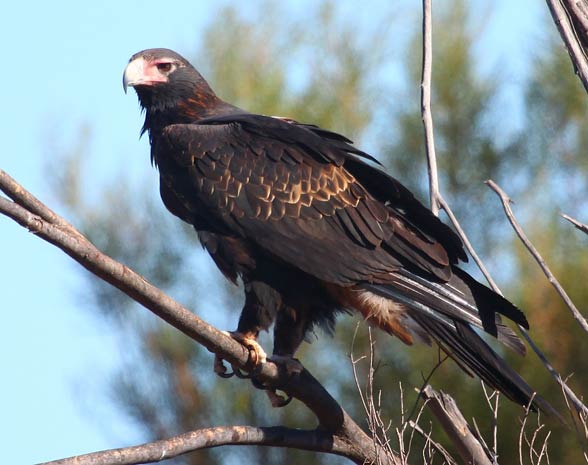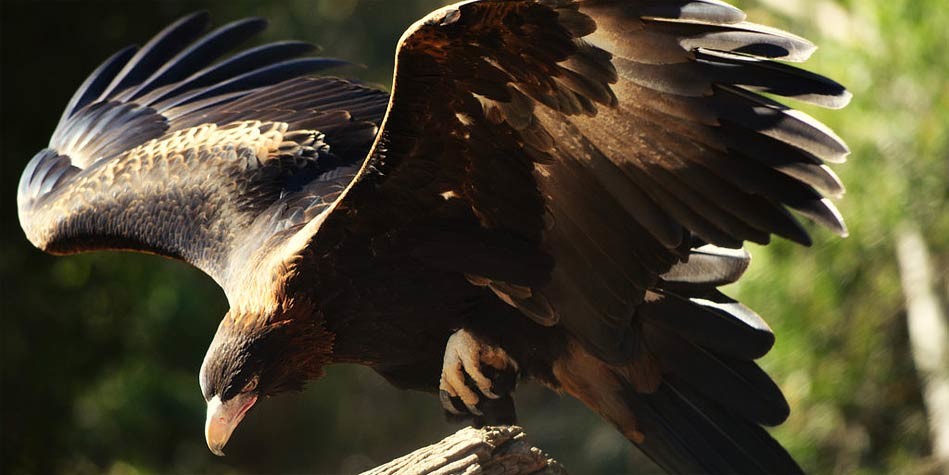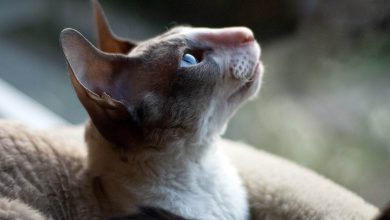Wedge-tailed eagle, eaglehawk (Aquila audax)
The Australia’s mightiest bird of prey – the king of Australian skies. In terms of coloration it bears resemblance to the golden eagle (Aquila chrysaetos), yet it has a larger beak, it is also one of twelve Aquila genus eagles with dark feathers on almost whole its body. What else we are to know about the wedge-tailed eagle?
Classification
- Class: Aves
- Order: Accipitriformes
- Family: Accipitridae
- Genus: Aquila
- Species: Wedge-tailed eagle (Aquila audax)

Areas of occurrence
This eagle habitat includes the whole of Australia, Tasmania and the southern regions of New Guinea, yet it favors the open spaces of southern and eastern Australia plus the lesser islands: Maria Island, Flinders Island, and Kangaroo Island.
It often takes off using dead trees, telegraphic poles, or rocky hills as a starting ground. It nests in the forests and savannas, as well as on woodless plains, whereas it can be observed in crop fields or in close proximity to human settlements extremely seldom.

Characteristics
Size
Females weigh from 3 to over 5 kg (6.6 – 11 lb), while males reach from 2 to 4 kg (4.4 – 8.8 lb) of weight. The mean body length ranges between 81 and 106 cm (32 – 42 in), whereas the wingspan is 182 – 232 cm (72 – 91 in). As this species inhabits the wide open-air areas, many eagles achieve remarkable wing sizes; the wingspan of the largest eagles may even exceed 280 cm (110 in).
This species can be distinguished by the impressive length of its wedge-like tail, reaching 45 cm (18 in) – this eagle surely is a mighty and very characteristic bird.

Feathering
Long, but relatively narrow wings have distinctive stripes on their bottoms, with dark brown feathers with bright edges topside. The head is rather small and flat, equipped with a huge, crooked beak, the legs are covered with dark fluff from thighs to tarsi.
Adult eagles are dark brown or brown-to-black, apart from the brick red nape feathers and grey-brown speckles on the upper wings. Tail coverts are light brown and the primaries’ coverts are beige.
This bird has a brown iris, its face and feet being cream-colored. Both genders are very similar in terms of coloration, yet females reach larger size and body weight than males.

Offspring
Immature eagles are easily distinguished from the adult ones, as its feathers gain a dark brown tone with red edges, the nape, back and top of the wings are usually russet – the stripe of golden feathers is wider than among adult eagles and spreads along about 50% of the wing width.
The head and breast of an adolescent eagle are brighter, it has more colorful streaks, just as the bottom of the wings and tail.
Sometimes a completely black adolescent eagle may be observed.
Most of the ‘underage’ eagles have grey or bright brown eyes and a yellowish face and tarsus. Young birds are darker than adults and must remain patient, as they do not reach mature coloration until 7-8 years of age.
Subspecies
There are two identified subspecies of the wedge-tailed eagle: Aquila audax fleayi and Aquila audax audax. The former inhabits Tasmania and its distinctive feature is the white, cream-colored or brick red feathering on its nape. Adult eagles rarely have black feathers, which is nonetheless often observed in the continental subspecies – Aquila audax audax.

Diet and hunting strategy
The wedge-tailed eagle can glide on extensive altitudes for many hours, yet it has not been established if these flights are hunt-related. It is known for certain that it has outstanding eyesight allowing it to recognize prey, it also senses the air currents perfectly, so it can ascend freely without substantial energy expenses – just like albatrosses.
Prey
It most often attacks animals on the ground, choosing the victim over the criteria of its own convenience and capabilities. Since the Europeans’ arrival and introducing the brown hare (Lepus europaeus) into the ecosystem, it has become the main element in the eagle’s diet. Apart from them it often hunts for: foxes, feral domestic cats, small kangaroos, feathertail gliders, koalas and bandicoots, it can also eat other birds: cockatoos, mallards, crows and ibises.
It rarely feasts on reptiles: frilled-neck lizards (Chlamydosaurus kingii), monitors and eastern brown snakes (Psedonaja textilis). It can also hunt down an emu, yet we have no information on its largest flying prey.

Adaptation in relation to the hunting strategy
The wedge-tailed eagle shows considerable adaptive abilities, which allow it to hem e.g. a wild goat, sheep or a kangaroo into a steep slope, to block their escape and separate them from the rest of the group.
It normally chooses the most feeble animals for its prey, and however its hunts are usually solitary or aided by one partner, it happens to hunt in small groups nonetheless (on such occasions the hunted animal may be larger – an emu or a kangaroo).
Carrion proves to be quite a substantial element of its diet, as for the Australian raven (Corvus coronoides), which circles around the dead animal it finds, to lower its flight and subsequently begin its meal.
The wedge-tailed eagle is often observed in rural areas,, abundant with domestic animals, which regularly become roadkill.

Lifestyle and character
The wedge-tailed eagle spends most of its time on high trees, rocks or other good vantage points. It sometimes performs low flights over its territory. In the hottest periods, it glides high in the thermal columns.
Each hatching pair occupies a territory of 9 to even 100 km2 (3.5 – 39 mi2) Their presence in a given area is demonstrated by high-altitude gliding flights.
The moment an intruder enters its territory, the wedge-tailed eagle performs a dive towards the trespasser. The bird may allow itself to be impetuous and aggressive, for it is an apex predator, without any natural enemies. However, it has to protect its eggs and nestlings from other predators e.g. ravens, currawongs or other eagles.

Aggressive bird reputation
The wedge-tailed eagle is said to be aggressive, but attacking only as an act of territorial defense (although such behavior is hardly an attack, as no ‘strikes’ resulting in wounds or any other harms to the human body were recorded).
The sole presence of this eagle evokes panic among lesser birds e.g. butcherbirds, masked lapwings, or noisy miners, which often results in harassment of the eagle predator by those small, relatively combative species.

Breeding
The mating process involves spectacular aerial stunts over the eagle’s own territory. Sometimes males perform dynamic diving flights towards their partners, to ascend right behind the female again, circling above it with its wings widely spread; a female may ignore the courtship or join the male as an act of acceptance.
The hatching season lasts from April to December, depending on the inhabited region, e.g. the populations of Northern Australia reproduce between January and February, whereas the Tasmanian pairs – between August and September.

Nest
A pair builds or reinforces the nest, which will be used throughout many years, after multiple developments it can be 2 – 5 m (6.6 – 16ft) wide in diameter and also 2 – 5 m (6.6 – 16ft) deep.
The nest is usually built on a large tree, sometimes on rocks or cliffs or even on the ground. Green leaves and twigs provide building material. One pair may have several nests on their territory, yet usually only one is in use.

Offspring
A female usually lays 1-2 eggs which are incubated by both parents for the next 42 – 48 days. Nestlings grow feathers after around 70 – 95 days after hatching, staying under parental supervision for the first 3 – 6 months – in this period they are fed by their parents. After these several months, young eagles leave the home territory. Sexual maturity is reached between 3 and 5 years of age, but they start to reproduce 2 or 3 years later.

Detailed characteristics / size
Wedge-tailed eagle (Aquila audax)
- Length: 81 – 106 cm (32 – 42 in)
- Wingspan: typically 182 – 232 cm (72 – 91 in), largest recorded: 284 cm (112 in)
- Tail length: 45 cm (18 in)
- Weight:
- females: 3.0 – 5.77 kg (6.6 – 11.2 lb)
- males: 2 – 4 kg (4.4 – 8.8 lb)
- Speed:
- flight: to 80 km/h (50 mph)
- dive speed: no data
- Lifespan:
- 20 – 25 years in the wild
- up to 40 years in captivity
Sexual dimorphism is apparent in terms of size – females are larger and heavier than males.

Wedge-tailed eagle (Aquila audax) – interesting facts
- The wedge-tailed eagle is the largest raptor in Australia.
- The wedge-tailed eagle is able to glide at an altitude of 1800 m (5900 ft).
- The wedge-tailed eagle’s eyes allow it to see in infrared and ultraviolet light.
- The wedge-tailed eagle is able to hunt down an emu.
- Tasmanian wedge-tailed eagles are rivals with white-bellied sea eagles (Haliaeetus leucogaster) over nesting spots.
- Some nests are used for over 50 years, obviously by several eagle pairs.
- The wedge-tailed eagle profile has been used in the badge of the New South Wales Police Force.
- The wedge-tailed eagle is a noisy bird, it emits loud whizzes and squeals, plus gentle vocalizations resembling ‘sii-tyu’.

Recommended
- Animals records
- Largest eagles Top10
- Largest birds of prey
- Haast’s eagle
- Bald eagle
- Steller’s sea eagle
- Philippine eagle
- Crowned eagle
- Fastest animals – Top 10
- Fastest birds – Top 10
- Most venomous snakes – Top 10
- Largest sharks Top 10
- Heaviest land animals
- Largest crocodiles Top 10
- Largest whales TOP 10
- Longest snakes Top 10
- Highest (Top) flying bird – Top 10
- Largest and heaviest birds
- Largest turtles TOP 10



















I LOVE EAGLES